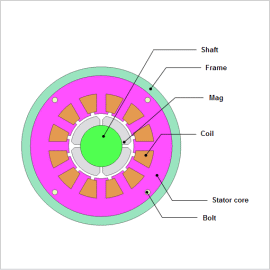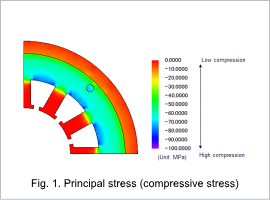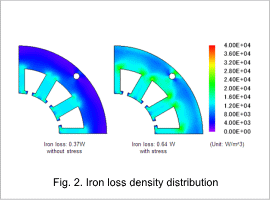*Please prepare a license ID and password for the license administrator.
*It is different from the service for JMAG WEB MEMBER (free membership). Please be careful.
Overview

A magnetic steel sheet is used for the iron core in a motor. A frame is shrunk into a stator core in order to sustain the laminated structure and to improve the strong joint between the frames. It is know that a compressive stress is generated during the shrinking process which increases the iron loss process. Therefore, it is important to account the affects of stress during iron loss evaluation. Therefore, it is important to account the affects of stress during iron loss evaluation.
An iron loss is generated by the magnetization field in displacement with a steel sheet. The size of the iron loss is dependent on the iron loss properties of a steel sheet. Iron loss characteristics of a steel sheet deteriorates when there is stress in shrinkage. The stress generated by the shrinkage is distributed in areas in which the section in the back yoke becomes large. In order to evaluate the iron loss with good accuracy, it is necessary to obtain the stress distribution for the magnetic flux, time variation, and steel sheet with accuracy.
This note presents an analysis to obtain the iron loss density of an SPM motor both including and not including the stress caused by shrink fitting.
An iron loss is generated by the magnetization field in displacement with a steel sheet. The size of the iron loss is dependent on the iron loss properties of a steel sheet. Iron loss characteristics of a steel sheet deteriorates when there is stress in shrinkage. The stress generated by the shrinkage is distributed in areas in which the section in the back yoke becomes large. In order to evaluate the iron loss with good accuracy, it is necessary to obtain the stress distribution for the magnetic flux, time variation, and steel sheet with accuracy.
This note presents an analysis to obtain the iron loss density of an SPM motor both including and not including the stress caused by shrink fitting.
Compressive Stress Distribution

The iron loss density distribution is indicated in Fig. 2. The iron losses increase up to 7 times depending on whether or not the stress is applied. An analysis that accounts for the thermal stress caused by shrink fitting needs to be performed to evaluate the iron losses more accurately because the iron losses increase when the thermal stress is applied.
Iron Loss Density Distribution

The iron loss density distribution is indicated in Fig. 2. The iron losses increase up to 1.5 times depending on whether or not the stress is applied. An analysis that accounts for the thermal stress caused by shrink fitting needs to be performed to evaluate the iron losses more accurately because the iron losses increase when the thermal stress is applied.


